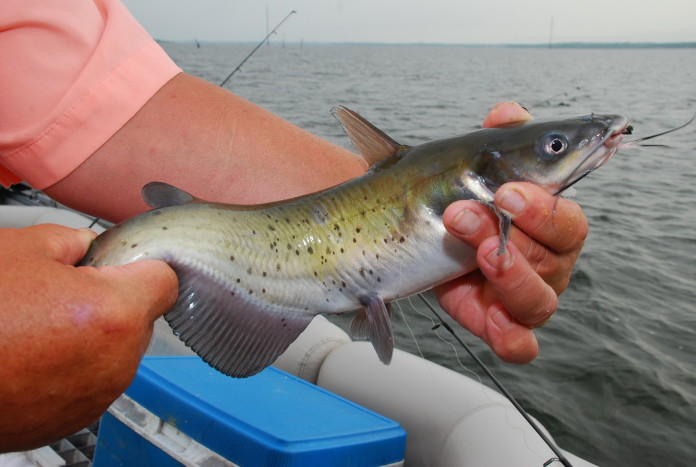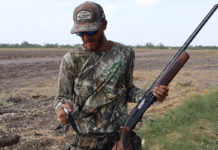
The catfish ranks only behind the largemouth bass in terms of anglers’ preference, as you would expect, and we’ve got exceptional catfish habitat in Texas. Flatheads, channel cats and blue cats can be found in almost every nook and cranny of the Lone Star State and are more than willing to take a variety of bait offerings all year long.
In addition to having a thriving catfish population, fisheries biologists with the Texas Parks & Wildlife Department have worked long and hard on a plan designed to expand angling opportunities for Texas’ growing urban population and introduce the next generation of anglers to fishing. That plan “A Vision for Catfish in Texas,” which debuted last year, describes why catfish are likely to become more important to Lone Star State anglers in the future and presents goals and strategies designed to make catfish angling better.
“Texas has some outstanding catfishing opportunities,” said Dave Terre, chief of research and management for the Inland Fisheries division. “We believe our public waters have great potential for providing quality catfishing in the future, and we have the experience and expertise to maintain and expand the fishery. However, success will depend on having the support of anglers, industry, civic organizations and local governments.”
You’ve only got to read a quick TPWD report on one catfish honey hole to understand just how abundant the methods are for catching catfish, and how varied they can be as well, making it the ideal species to help introduce a whole new generation to the outdoors.
“Channel catfish are taken near the mouths of creeks after a rain, especially in spring and fall. In late spring and early summer, they are found around rocky shores and areas of rip-rap. Best baits are shrimp, blood bait, cut bait, dough bait and shad gizzards. In summer, try drift-fishing shrimp across flats. Sunfish and large minnows also pay off here. Blue catfish are caught on many of the same baits. Try juglining with live gizzard shad for bait. A rod and reel baited with live shad on windless winter days works well, too. Flathead catfish are infrequently caught by rod and reel anglers, but most often by trotlining with live sunfish for bait.”
Any guesses on what lake biologists were discussing? If you said Lake Texoma, on the Texas-Oklahoma border, you’d be correct.
Central Texas catfish angling great in Colorado, Brazos rivers in summer
It’s safe to say that almost anywhere with water is a possible locale for catfish, but some hot spots do stand out above the rest. In North Texas the names Texoma and Tawakoni come to mind and in East Texas it’s Fork, Livingston and Richland-Chambers. Central Texas anglers know that Buchanan, Waco and Whitney are their best bets while South Texans can bank on Braunig, Calaveras and Choke Canyon for producing limits.
However, there are numerous other places that are rated at least good by biologists and fisheries experts. TPWD also is in the business of improving fish habitat, something that is vital for a variety of species, including catfish. It’s no secret: if you better the overall landscape of a body of water, you improve the overall fishing, which is precisely why TPWD has partnered with a number of groups including the Brazos River Authority and Army Corps of Engineers to enhance habitat with artificial structures. These fish attractors include habitat made from recycled plastics and natural structures made of recycled bamboo to Christmas trees. The best part is that the fishing coordinates on these lakes across the state are listed online.
It’s well-known that much of Texas often suffers from lingering drought, which can be extremely detrimental to fishing access and fish populations as a whole. However, by providing increased habitat, it’s TPWD’s hope that any negatives are somewhat alleviated.
“The Christmas tree piles will eventually break down but will provide habitat in the shallower areas of the reservoir,” said Michael Homer Jr., Inland Fisheries Division district supervisor in Abilene. “Artificial reef areas will persist much longer and may be crucial refuges for fish when water levels drop. We have taken the necessary steps and worked with the controlling authorities to identify areas in each lake that are not only safe but will also maximize the benefit to the fisheries.”
Catfish forecast
Here’s a look at your best bets for catfish angling in Texas, thanks to input from biologists and anglers.
East Texas is a haven for catfish, and while the standouts are easy to name quickly, you shouldn’t overlook the rest of the pack. It’s hard to overlook Toledo Bend (at nearly 200,000 acres it’s one of the largest lakes across the South) but the reservoir on the Louisiana border known as a crappie hot spot also is good for cats, featuring the three well-known versions (blue catfish, channel catfish and flathead catfish). Cut bait and natural bait of any kind are perfect for the first two, while live bait dropped near submerged vegetation and laydowns works for flatheads all year long.
Sam Rayburn, north of Jasper, is known more as a largemouth bass honey hole but it too has loads of cats, with the lake record blue weighing 53 pounds and its record flathead coming in at just over 74 pounds. It’s also hard to overlook Wright Patman, southwest of Texarkana, and Lake O’ The Pines, northeast of Longview. Patman features superb catfish habitat, including inundated timber, brush, creek channels and riprap, while Lake O’ features much of the same and fish-holding hydrilla as well. If you’re simply looking to maximize your haul, consider a trip to Palestine, which features a daily bag and possession limit of 50 blue and channel catfish in any combination, with no minimum length limit (only five can be over 20 inches).
North Texas anglers also have it good, with the usual suspects such as Texoma and Tawakoni being in the top 10 when it comes to catfish. However, don’t overlook two lakes that are rated excellent by TPWD even though they’re vastly different in scope. Lewisville, near the town of the same name, is another lake with differing size limits. For blues, there is a 30- to 45-inch “trophy” slot. Fish 30 inches and less or 45 inches or greater in length may be retained. Only one blue catfish 45 inches or greater may be retained each day. For channel catfish, minimum length is 12 inches. The daily bag is 25 blues and channel cats in any combination. Fishing cut shad near the bottom is a great way to target blue cats and the lake record topped 63 pounds.
Coffee Mill, northeast of Bonham, is only about 600 acres but has some of the highest fish densities in the entire area. The lake is off limits to some methods, with trotlines, throwlines and juglines prohibited, but that shouldn’t keep you from throwing a variety of prepared baits, especially those specifically targeting channel cats. Lake Arlington also is a channel catfish haven, perhaps the best in the Dallas/Fort Worth area. The fish are abundant and grow big, with fish in excess of 10 pounds a common theme. Usual choices of stinkbait and other prepared baits always produce limits for anglers.
CenTex anglers may have some of the best metro fishing in the country, with plenty of hot spots in and around the Austin area, but some lakes do stand out for cats near the Capitol. Granger, northeast of Austin, is another excellent crappie lake that features great numbers of all three species of catfish. Trotline and jugline fishing are popular techniques for large catfish on the lake but big cats also are caught by targeting rod and reel efforts around snags and laydowns, especially in the river portion of the lake. Another great catfish spot is LBJ, near Marble Falls. The scenic lake is known as a great bass haunt but it also features good numbers of catfish, particularly blue cats. The LBJ record blue cat weighed 35 pounds and casting cut shad and fishing just off the bottom, whether from the bank or from a boat, is the method of choice for those critters.
West Texas lakes have been hit hard in some areas by golden algae outbreaks, but there are some hot spots that still exist. Kirby, a 700-acre lake near Abilene, is another lake with expanded bag limits. For blue and channel catfish there is no minimum length, with a daily bag and possession limit of 50 fish in any combination, of which no more than five may be 20 inches or longer. This is another bank-fishing hot spot to consider. Fort Phantom Hill, another Abilene-area lake, is among the lakes statewide affected by low levels in drought times, but it still harbors lots of fish. Blue cats can be caught in all areas of the lake, but the most popular areas are at the spillway, sailboat slough and the area near the dam.
Catfish tackle
Catfish anglers shouldn’t bring a lot of excess gear simply because catfish don’t require a lot of special rigging or frills. Channel cats easily can be caught using small terminal tackle, such as a No. 6 hook baited with some type of prepared bait and weighted down with a split shot and fished near the bottom. Eight- to 14-pound line usually is significant for these smaller catfish. However, for flatheads and blues, anglers need to up their gear choices.
The one area where you cannot afford to skimp is hook selection. You will want the sharpest, most durable metal you can get your hands on and for good reason – catfish, especially big, old ones have tough mouths. Cheap hooks will only madden an angler who either won’t be able to hook a big one or worse yet lose them.
Rigging options remain almost infinite, but two easy prepared bait rigs that seem to work just fine for almost any catfish trip can be fished near the bottom. The first one is to tie on a barrel swivel with a slip sinker above it and then tie on a heavier leader below it equipped with either a circle or treble hook. The leader can be as long as you want, but the shorter it is the easier it is to cast to a specific spot. Another easy rig is the drop shot, which simply can be tied using a Palomar knot at your hook while leaving a longer tag end where you can attach some kind of heavy sinker weighing an ounce or more. These rigs can be fished in a variety of situations, but if you’re having difficulty with current, which normally isn’t a big problem in most places, you can go heavier on the sinker to get it to take root on the bottom. The dropper rig in particular can add zing to an offering if you’re using live bait such as nightcrawlers that will dance mightily in the slightest current.
Catfish limits
The statewide bag limit for flathead catfish is five per day with a minimum length of 18 inches and no maximum length. For the channel cats and blue cats, the daily bag is 25 in any combination with a 12-inch minimum and no maximum length. There are some lakes with a “trophy” slot size limit – blue catfish 30 inches and less or 45 inches or greater in length may be retained. Among those are Waco and Lewisville, and on those lakes only one blue cat 45 inches or greater may be retained daily.
Invasive freshwater threat
Zebra mussels, an invasive species that has taken over the Texas freshwater landscape, are a scourge that aren’t going away. In fact, TPWD has enacted regulations requiring anglers and boaters to clean, drain and dry boats, trailers, livewells and bait buckets, and other gear before traveling to another water body. Draining water is required by law and possession and transport of zebra mussels is illegal.


















